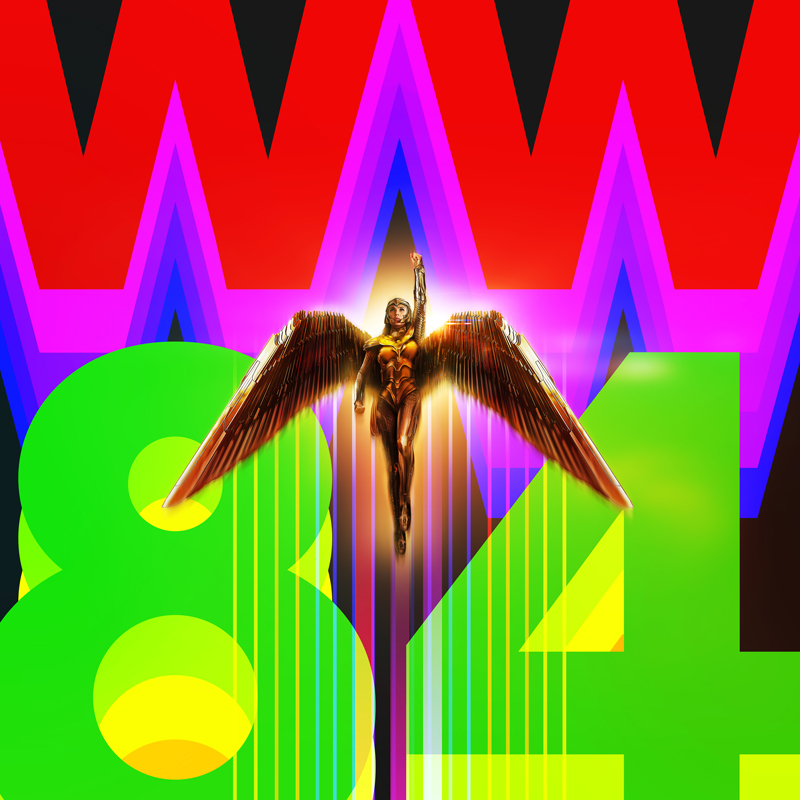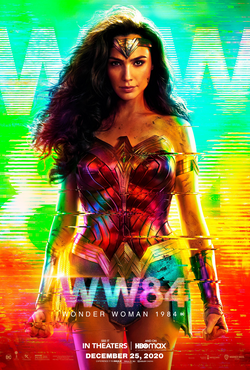December 26, 2020
Score Album Review: WONDER WOMAN 1984
Hans Zimmer/WaterTower Music – digital
By Randall D. Larson/MusiqueFantastique.com
Slightly edited and abridged from original publication in Soundtrax, December 2020
Hans Zimmer’s score to WONDER WOMAN 1984 is full to the brim with bright, heroic, rousing orchestral themes, and those who have complained about too many drones in recent years are going to be very surprised at the melodic richness of this new superhero score [as for me (I willingly digress) I’ll go on record as having found much to treasure in the music of DUNKIRK and other of Zimmer’s tonally oriented scores]. WONDER WOMAN 1984, logically enough, fast forwards from the 1940s of Patty Jenkins’ 2017 WONDER WOMAN film as circumstances in 1984 find her riding lightning across the sky, donning wings of gold, and chasing a dream while in pursuit of two new formidable foes: ruthless what-do-you-wish businessman Maxwell Lord and co-worker-cum-nemesis, Cheetah. In WaterTower’s recent press release, Patty Jenkins discussed her work with Hans Zimmer on WONDER WOMAN 1984: “Not only did the film require the multiple themes that had to relate to the era of the 1980s, but on top of that, Diana, our Wonder Woman, was now unfolding into a much more complex character with many new subtle layers of emotion.” This required music of a different sort from the original theme that Zimmer had written for the Wonder Woman character when she was introduced in BATMAN V. SUPERMAN: DAWN OF JUSTICE (the same theme—shall we call it “Wonder Woman’s Battle Theme?”—was also included briefly by Rupert Gregson-Williams in his score for WONDER WOMAN, validating the theme’s connection to the character). “It was very important to both of us to include and celebrate that beloved battle cry of a track that has now become so… synonymous with her character,” Jenkins continued, “but Diana also now required a much purer and more heroic theme. And Hans provided the most mind-blowing suites of themes for Wonder Woman to now use, all related to and unfolded from his original track.”
Zimmer has essentially written an orchestral 1980s’ styled score for a film taking place in the middle of that decade, and this musical approach gives this film exactly what it needs. From the reintroduction of the island of Themyscira, home of the Amazons, in the first track, we’re led into “Games,” where many of the Amazonian warriors, including a young Diana, a few years along in her training from the opening of the first movie, are preparing to take part in the Amazon Olympics. The track is rich with female vocalizing as the gathered athletes deliver their opening ceremony, which joins with Zimmer’s choir into a rhythmic cadence that unites with the orchestral Themyscira motif in a paean to the Amazonian prowess, with strings and drums propelling the fanfare into a grand, heroic orchestral crescendo, softening to allow the track to end with a quiet dignity from choir and gleaming brass. The film’s title theme appears in “1984,” a magnificently presented seven-minute-long rhythmic anthem comprised of another Olympic-like motif from full orchestra sparkling with triangle, bells, etc. as it rollicks along. It’s absolutely cheer-worthy in its feel-good bravado. Midway through, the track turns a little dramatic for some business, and then reestablishes the sheer pleasure of its exuberance through its end. “Black Gold” introduces our main villain, Maxwell Lord, with strident strokes of strings beneath a brass melody, arranging itself into a hearty, rhythmic cue until diminishing into a tense, breathy mix of strings and soft choir. “Wish We Had More Time” establishes the love theme between Diana and Steve in a beautifully impassioned melody for strings, very much like something from Golden Age Hollywood (perhaps reflecting their original romance from the 40s).
“The Stone” offers up a rising, heraldic motif for the Dreamstone, a mystical gem that allows one to have a single wish granted, which is how Steve Trevor reunites with Diana in 1984, and how Max Lord creates a world of havoc in his megalomaniacal quest for power. Zimmer offers an interesting mix of string orchestra and burbling synth tonalities to create an unusual sonic color, with winds taking the melody at the end with an intriguing new flavor. “Cheetah” provides a motif for Diana’s primary adversary: largely string-based material beneath a ringing bell tone that provides a beat for the opening few measures until the music shifts into a melodic ten-note phrasing over a low, see-sawing violin chordal structure; some aggressive downward spirals of the Battle theme, and then introduce a languid, slow-ranging series of brass notes that resonate assertively while the cue drifts out. “Fireworks” is another beautifully festive theme, a vociferous delivery of the love theme: big and bold and assertive during Dianna and Steve’s flight in the invisible airplane over Washington DC on the 4th of July. Maxwell Lord’s theme is reprised in “Anything You Want,” where its two-note rhythm drifts amidst rippling synth pads and keyboard notes; an introduction of strings a third of the way through creates a menacing pattern through which a pleasing violin melody drifts; the cue opens with a bar of Cheetah’s theme, linking the two villainous characters together, and concluding in a bold, brash statement of Lord’s theme.

“Open Road” gives way to a full-on angry Battle theme during one of the film’s major action sequences, while “Without Armor” is a more subdued, reflective presentation of the love theme for strings and piano. In the seven-minute “White House” action scene, we have a variety of assertive and aggressive high points along with several effective statements of the Battle theme with Cheetah’s theme as the two characters face off. “Already Gone” returns us to the Diana/Steve love theme with a critical level of emotional gravity, intoned by soft brasses, impassioned strings, and choir, all of which grow to a fairly intense dramatic elevation. The 8-minute “Radio Waves” is a dynamic cue comprising a variety of frenzied action material; as the cue develops, Zimmer imparts elements of both his Themyscira and Battle themes, after which “Lord of Desire” intones wickedly in a growing choral and brass progression of Lord’s theme, finally reaching a marvelously powerful and malevolent summit. “The Beauty Is What Is” is quintessential Zimmer: a mounting built-up of mercado strings and walking brass chords slowly propelling their way across the soundscape, finally coming to a halt, taking a breath or two, and fading out. “Truth” effectively concludes the score with a passionate recap of it’s primary themes, building a massive interpretation of the Themyscira theme for brass choir and rendering a final, percussive reprise of WW 1984’s main theme for full orchestra, enhanced by hammering drums, carrying the music to a most satisfying finish. An almost 12-minute bonus track, “Lost and Found,” presumably containing material that wasn’t used in the score proper, is added to the end of the album, largely offering an extended arrangement of the love theme that allows its beauty and emotive capacity, particularly in a few violin solos, choir intonations, and welcome crescendos along the way, to resonate fully across the track’s length.
This is one of Hans Zimmer’s most engaging scores of recent years; the 90-minutes of music included on the score album and its variety of vivid orchestral elements, colors, and emotions provides a compelling listening experience on its own, apart from its thrilling and expressive use within the movie itself.






